Theatrical viewing, early 2025
Since retiring at the end of December, I’ve been to see a movie in the theatre more times in five months than in all of the last year. One reason is the bundle of coupons and the Cineplex gift card my co-workers gave me as a parting gift; but equally, it’s because I can go to weekday matinees when there are few people in the theatre and less chance of being annoyed. On one occasion, my friend and I were the only people there, essentially getting a private screening. But although this makes the experience more tolerable, I can’t say everything I’ve seen has been satisfying.

Nosferatu (Robert Eggers, 2024)
The high point remains Matthew Rankin’s wonderful Universal Language, which I’ve already written about, while perhaps the biggest disappointment was Robert Eggers’ Nosferatu – although my expectations weren’t terribly high. For some reason, this was a project Eggers had been nursing since The Witch (2015), but why he should have been driven to remake F.W. Murnau’s unauthorized adaptation of Dracula remains obscure to me, despite having heard him being interviewed about the project. Obviously, he wasn’t deterred by Werner Herzog’s unsatisfying attempt in 1979. Murnau’s film was a key work in post-World War One Weimar cinema, emerging from the horrors of war and the psychological stress of defeat with a haunting vision of social contagion. Separated from its own time, Murnau’s sense of thematic urgency seems in Eggers’ version more of an academic exercise, a commentary on a particular style of artistic production rather than on issues of immediate social and political concern.
While Eggers self-consciously evokes the visual effects of silent Weimar cinema even more than Herzog did, the question is what original perspective, if any, does he bring to the overly familiar material? I found only two points of note, one somewhat positive, the other rather distressingly negative. The latter is a deep strain of misogyny; in a prologue, the burgeoning sexuality of Ellen (Lily-Rose Depp) somehow calls across space and time to resurrect Count Orlok (Bill Skarsgård), setting in motion events which will not only imperil her eventual marriage to Thomas Hutter, but also bring a devastating plague to Wisburg – adding a touch of xenophobia as Eastern degeneracy threatens Western civilization. Like Eve, Ellen has introduced sin to the world – and there’s only one way to extirpate it; Ellen must sacrifice herself for the good of mankind. Women, it seems, are inherently impure, their desires a threat to the very survival of humanity.
The positive element, however, is much appreciated – Eggers has restored to the vampire its monstrosity, wiping away decades of increasingly vapid romanticism by making him an unsavoury parasite and predator devoid of any attractive characteristics (which further soils Ellen’s erotic attachment to the creature). Skarsgård is a pustulent, decaying animated corpse who sucks leech-like not from the neck but directly from the heart with loud, moist slurping sounds which are genuinely repulsive. But that aside, the entire time I was watching the film I couldn’t help asking myself why Eggers had bothered.
*
Three other movies were unsatisfying in different ways, though none were as obviously ambitious as Nosferatu.
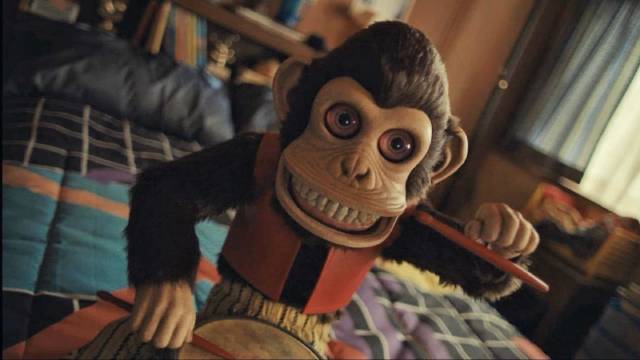
The Monkey (Osgood Perkins, 2025)
Osgood Perkins’ The Monkey, adapted from a Stephen King short story, is so sloppily constructed and tonally inconsistent that some of the rave reviews completely baffle me. After a prologue which seems to reference the Final Destination series with an elaborate Rube Goldberg death scene engineered by the titular toy monkey, the movie drags out a tedious narrative about murderous rivalry between two brothers rooted in a childhood incident. The malevolence of the toy remains unexplained and its targets are often unmotivated within the central conflict. And the movie never decides whether it’s supposed to be grossly comical or horrifically suspenseful. Like many adaptations of King’s shorter works, it tries to expand the spare narrative to fill the feature running time, but ends up just overloading the idea with a pointless string of barely connected incidents.

Novocaine (Dan Berk & Robert Olsen, 2025)
Dan Berk and Robert Olsen’s Novocaine seems to be aiming for the frantic, exaggerated comic violence of the Crank movies, but it somehow fails to think through its central conceit in a “plausible” way (I use the scare quotes because this is a matter of internal narrative coherence rather than a matter of “realism”). Nate (Jack Quaid) is an assistant manager at a bank who suffers from a genetic condition which makes him unable to feel pain. He lives in constant fear of injury, but starts to lose a lifetime of neurotic caution when he begins to date fellow employee Sherry (Amber Midthunder). When an armed gang raid the bank one day, killing the manager and taking Sherry as a hostage, Nate takes off after them, being flagged by the police as the inside man on the robbery.
What follows is a sequence of escalating action scenes as Nate takes on the gang members and evades the cops. The problem is, the movie confuses his inability to feel pain with a superpower which makes him essentially invincible. But his condition doesn’t actually make him impervious to injury; it just means he can’t feel injuries when they occur (hence his previous lifetime of excessive caution). Long before the final showdown, his body ought to have been so severely damaged that he’d be dead – each new catastrophic injury serves only to make the movie seem more irritatingly stupid.
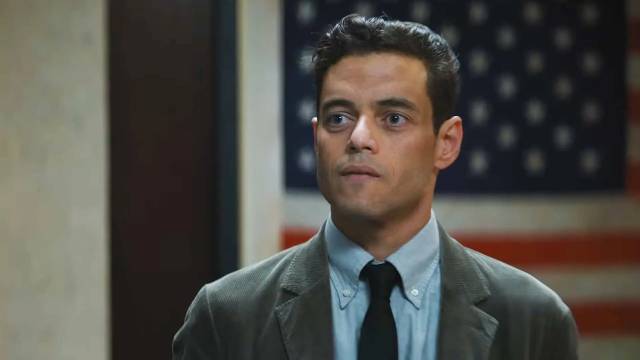
The Amateur (James Hawes, 2025)
James Hawes’ The Amateur, on the other hand, is simply numbingly dull. What ought to have been a breathless Bourne-style thriller never overcomes its soporific protagonist. Heller (Rami Malek) is a CIA analyst married to another agent; while on a trip to Europe, his wife is killed during a botched terrorist raid on an international meeting. Dissatisfied with his bosses’ seeming lack of interest in going after the killers, he accesses some high level secrets and blackmails them into giving him field training so he can track down and kill the gang. Although he appears to lack the necessary field skills (and will to kill), what the Agency fails to understand is his superior intelligence skills; he gives them the slip and heads to Europe, tracking down and killing the terrorists one by one as the CIA tries to eliminate him – and of course he eventually uncovers a secret unit inside the Agency which carries out illegal off-the-books missions, one of which resulted in his wife’s murder. All of which might work just fine if Nate was played by an engaging, charismatic actor, but Malek seems to be unable to summon up anything stronger than petulant annoyance, which saps the cat-and-mouse pursuit of any tension and makes the occasional action sequences seem tiredly perfunctory.
*
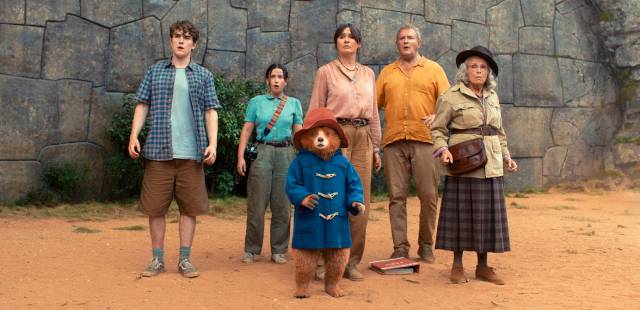
Paddington in Peru (Dougal Wilson, 2024)
But it hasn’t all been disappointment and annoyance. I admit that, as a big fan of Paddington (2014) and Paddington 2 (2017), I was a bit wary because original writer-director Paul King had relinquished the reins to first-time feature director Dougal Wilson, whose previous work was mostly music videos. I was also sad to see that Sally Hawkins had been replaced as Mary Brown, the wistful yet firm bedrock of Paddington’s adoptive family, by Emily Mortimer, a fine actress but perhaps not as good a fit for the whimsical fantasy of the films’ alternate middle class England. But I needn’t have worried; Wilson captures the delightful flavour of the world King had established – perhaps not quite as rich in character, with a greater emphasis on action set-pieces – and Ben Whishaw’s performance as Paddington continues to express the guileless belief in decency which makes the series so charming.
This time, having received word that the little bear’s Aunt Lucy (Imelda Staunton) has disappeared from the home for aging bears back in Peru, Mrs Brown persuades her cautious husband (Hugh Bonneville) to take the family back to the jungle to find her. Once there, they encounter the sinister nun who runs the home (Olivia Colman), a slightly mad riverboat captain (Antonio Banderas) and his daughter (Carla Tous), and various natural and human hazards as they uncover not only the secret of conquistador treasure but also Paddington’s own origins. Fast-paced, full of visual and verbal wit, Paddington in Peru maintains the high standard set by King in the first two films.
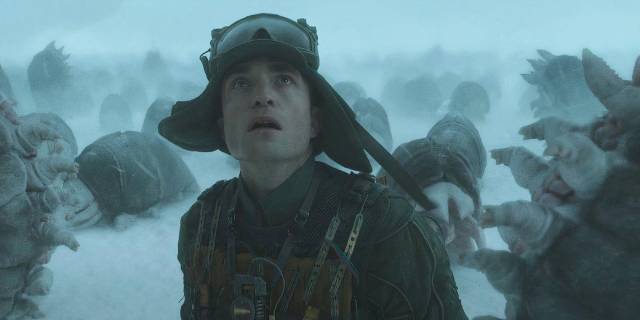
Mickey 17 (Bong Joon-ho, 2025)
Rather like Guillermo Del Toro, Bong Joon-ho alternates smaller, more serious films with large-scale entertainments, the two strains occasionally merging – his international break-through, The Host (2006), combined his concern with contemporary issues of class in South Korea with a rousing kaiju extravaganza. In both registers, even at its darkest, Bong’s work has a powerful strain of satirical humour – perhaps most perfectly expressed in his award-winning Parasite (2019). In his most recent film, Mickey 17, he revisits many of the elements of Snowpiercer (2013) – it’s satirical sci-fi set on an ice planet (though not Earth this time) where class issues and corrupt authorities make life miserable for regular people. Here, Bong also explicitly references the ecological concerns of Hayao Miyazaki, particularly Nausicaä of the Valley of the Wind (1984), borrowing the design of Miyazaki’s giant bugs, the Ohm, for the native creatures of the planet Niflheim.
Beginning as a dark comedy about a guy (Robert Pattinson) who inadvertently signs up for an off-world mission as he tries to hide from a murderous loan shark, it bounces between comedy and horror, action and overly broad satire (a truly insidious, smarmy politician [Mark Ruffalo] is a cartoonish avatar of Trump), before plunging into colonialist genocide. The cast is excellent, the production design impressive, and the central conceit interesting – although the latter can’t hold up to close scrutiny. Mickey’s assignment is to be an “expendable”, a worker drone tasked with the most dangerous jobs; his mind is uploaded regularly to a server so that whenever he dies it can be downloaded to a new cloned body which is “born” with all his memories. When he’s lost in a chasm out on the ice and presumed dead, a new version is 3D printed before he manages to make his way back to base (with the help of the native creatures which turn out not to be just big bugs but rather a highly intelligent species).
So Mickey has to navigate a complex mix of problems. Not only are such duplicates against the law, they’re considered abominations, and Mickey’s new second self is more aggressive and constantly risking their exposure to the authorities, while the minions of the loan shark have tracked him down. On top of which, he’s the only one who knows that the native creatures are sentient and he must do what he can to prevent the politician’s slaughter of them. Bong paints all this with broad brush strokes, alternating Mickey’s identity crisis with big action scenes and the cartoonish bloviating of the politician and his obnoxious wife (Toni Colette reprising Tilda Swinton from Snowpiercer). It’s quite entertaining, but all through I was bugged by a logical problem with the character of Mickey – everyone is always asking him what it’s like to die because he’s done it so many times (hence the “17”), and we see him dying over and over again, but his memories are uploaded weekly, not continuously, so only on a couple of occasions as cruel lab tests are being conducted would there be any memory of death to download into the next iteration – new Mickeys wouldn’t actually remember the moment of death, so the running gag of him coping with the repeated experience doesn’t actually make sense (a simple script tweak explaining that he’s permanently connected to the server via Bluetooth could’ve fixed this, which is why it was so annoying). If you’re going to make such a conceit a big part of the narrative, you really should think it through so that it actually works the way it’s supposed to.
I enjoyed Mickey 17 more than Snowpiercer, but it did make me wish that Bong would get back to what he does best – contemporary stories with their satirical elements grounded in a recognizable reality, like Parasite, Memories of Murder (2003) or Barking Dogs Never Bite (2000).
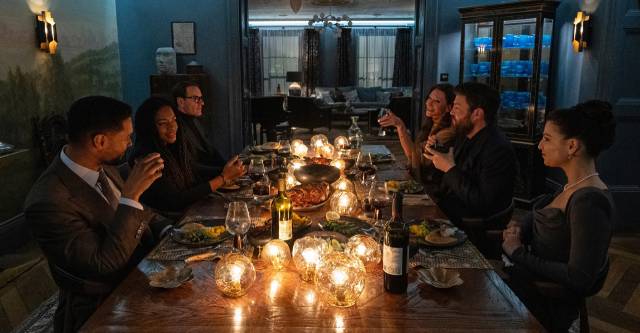
Black Bag (Steven Soderbergh, 2025)
Steven Soderbergh is almost absurdly prolific, turning out more than three-dozen features since his hit debut at Sundance with sex, lies, and videotape in 1989, as often as not also shooting and editing his films (under pseudonyms). As much as any moviemaker I can think of, he seems to breathe film, applying himself compulsively to a wide array of styles and genres from the mainstream slickness of the Oceans movies to the small indie likes of Bubble (2005). By this point, I’ve missed quite a few of his films, but I’m quite partial to his deft play with thriller tropes – from Out of Sight (1998) and The Limey (1999) to Contagion and even Haywire (both 2011), though I dislike the Oceans movies, which along with the title borrow a self-satisfied smugness from the Rat Pack original (1960).
I hadn’t seen anything since Unsane (2018), so had no particular expectations when I went to see this year’s Black Bag, though the cast was a definite draw. It turned out to be a deftly written psychological puzzle (with a script by David Koepp) – a bit reminiscent of David Mamet at his best, though with a lighter touch and more humour – which uses the elements of a le Carré-like espionage tale as the basis for a witty exploration of marriage between two forceful personalities. George Woodhouse (Michael Fassbender) and Kathryn St. John (Cate Blanchett) live a comfortable upper middle-class life in London, both working at high level jobs for MI6. The McGuffin is a secret plan which could trigger a catastrophic disruption in the tenuous balance of power between West and East; with this in play, George is given a week to find the mole who stole the plans – a job complicated by the possibility that his wife is the one who is trying to sell the plans to the Russians.
Rather than the kind of action familiar from movies like the Mission: Impossible, Bourne or Fast and Furious franchises, the tension here arises from dinner parties in George and Kathryn’s elegant home to which all the suspects have been invited. These include fellow employees Freddie Smalls (Tom Burke), Clarissa Dubose (Marisa Abela), Dr. Zoe Vaughan (Naomie Harris), Anna Ko (Kae Alexander), Colonel James Stokes (Rege-Jean Page) and Philip Meacham (Gustaf Skarsgård). Over an elaborate meal early in the film, George plays mind games with the three couples, probing for signs of weakness and hopefully provoking one of them to reveal signs of guilt. Following this, he surreptitiously surveils them – including Kathryn – while having to conceal what he’s doing from his own superiors (including Pierce Brosnan as the smarmy section head Arthur Stieglitz). Troublingly, all the signs begin to point towards Kathryn, but there are plans within plans and at a second get-together at the couple’s home, George does a fine imitation of Agatha Christie’s Poirot by gradually revealing everything he’s learned until the actual mole exposes himself in a climactic confrontation.
Black Bag is terrifically entertaining, its sophisticated genre play making the viewer feel smart as all the twists and deceptions are carefully laid out without either cheating or too bluntly spooning out its revelations. On the level of sheer craft, Soderbergh’s work is impeccable, making this one of his most satisfying movies.[1]
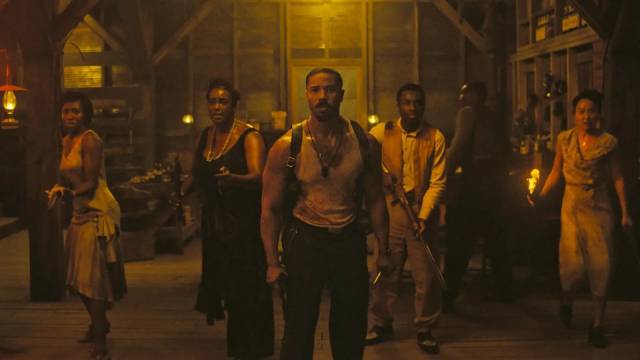
Sinners (Ryan Coogler, 2025)
I’d only seen one movie by Ryan Coogler – Black Panther (2018), which apart from focusing on Black characters and the effects of European colonialism in Africa was just another tediously overblown Marvel fantasy – but the trailer for Sinners looked intriguing and a friend told me she thought it was the best modern vampire movie, so I took in a matinee. Although it’s packed with interesting elements, overall it’s a frustrating mess as those elements never quite cohere into a satisfying whole. As at least one critic has commented, it would probably have been a better film if Coogler had stuck to the period narrative and scrapped the supernatural altogether.
The initial narrative set-up is definitely strong – twin brothers Smoke and Stack (both played by Michael B. Jordan through the magic of CGI) return to a small Southern town in 1937 after years away in Chicago, where they’re rumoured to have worked for Capone. Their big city gangster swagger makes them seem admirably sophisticated and old acquaintances pitch in to help them set up a juke joint in an old mill they’ve bought from a racist businessman. They rush to open on Saturday night, with their young cousin Sammie (Miles Caton) and aging alcoholic Delta Slim (Delroy Lindo) as the musical entertainment. Music, in fact, is one of the movie’s main focuses, with some impressive Blues which lead to what felt like Cooglar’s first misstep; he suddenly shifts into a metaphorical/mythical mode, with Sammie’s song transcending time and binding Black history and experience from the distant past into the future – symbolic figures appear among the dancing customers at the juke joint, tribal drummers, shamans, musicians with electric guitars and a DJ with his turntables … the sequence goes on and on, building to a fever pitch and igniting the mill which burns around the dancers until they all stand among the smouldering timbers. This breaks the until-then straightforward period narrative and leaves the rest of the movie to take place in some other space where it’s dominated by themes which are overtly spelled out in a heavy-handed way.
The power of the music has drawn the attention of Remmick (Jack O’Connell), a vampire with smooth Irish charm. He arrives at the juke joint (which of course didn’t actually burn down) in company with his latest converts, a married couple, and tries to get invited in. But Smoke and Stack are wary of letting in whites, even though Remmick insists that they’re here just for the music. To make his point, he and his companions break out into a Celtic folk song (though there’s a slightly menacing undercurrent to the lyrics). From here, the sense of racial menace which has hung over the film from the start is strangely offset onto conflicting musical traditions – although, as Remmick points out, both traditions are rooted in similar experiences of prejudice and oppression; as Blacks in the South still live under the shadow of slavery, the Irish have been crushed by centuries of British colonial rule.
Once Remmick and his companions have begun to turn members of the crowd at the juke joint and it’s become clear that the place is under a vampire siege, the newly vampirised friends and relatives back up their master’s claim that what he brings is freedom and solidarity, a better, more peaceful way of life in which race no longer matters because everyone is equal. (Once turned, a vampire shares the memories and consciousness of its fellows, erasing superficial differences.) Tension and bickering among the dwindling survivors begin to cast a strangely positive light on what Remmick promises – this new sense of community is represented by a party atmosphere in the parking lot when everyone breaks out into a rousing (and lengthy) Riverdance-like musical number, which reflects back, through a Celtic lens, to the earlier timeless Blues sequence. Both musical traditions bind communities against the forces which aim to oppress them.
The climactic destruction of the vampires thus seems problematic as it reasserts a status quo fraught with danger – which is reaffirmed when the racist businessman arrives with a small army of clansmen intent on slaughtering all those who had dared to believe they could exist here with some kind of autonomy. They’re surprised to find the mill deserted and locked up (everyone is dead but Sammie, who’s driven home, and one of the twins) … that is until they start being picked off by someone with a sniper rifle in the nearby woods. Smoke and Stack hadn’t returned from Chicago empty-handed and Smoke now slaughters all the racist rednecks before dying of his own wounds – as if the entire night had been some kind of dream which had enabled him to “resolve” the racist tension from the beginning of the film with a cathartic explosion of violence, though he can ultimately only achieve personal peace in death, which comes with a fantasy of reunion with his already dead partner and child. Or does Coogler actually mean for the audience to believe in an afterlife where the apparently tainted promise of Remmick can actually be achieved through … what? Is this the Christian afterlife, or merely a fantasy offering comfort at the moment of death?
The various tangled narrative and thematic threads remain unresolved and Coogler’s inability to find a coherent ending produces a jarring coda which interrupts the end credits with a jump ahead to 1992 and a now-elderly Sammie (Buddy Guy) performing in concert (with an electric guitar), after which he goes to a bar where he’s visited by his vampire cousin Stack and his lover Mary (Hailee Steinfeld) who had both survived the slaughter of the vampires in 1937 and, un-aged, have come to offer Sammie a permanent reprieve from death. But he’s lived a satisfying life during which he got to play his music and he has no fear of death … so the vampires leave him to his mortality and disappear into the night.
What does it all mean? I couldn’t say, but it does have its moments thanks to its unsettling depiction of the Jim Crow South and the sense of omnipresent danger within which the Black characters live. There’s some great music, both Blues and folk, and an interesting vampire in Remmick, who actually has a philosophy that he lives by. But among a number of unanswered questions, I do wonder what was with the small group of Choctaw who appear in one scene, chasing Remmick and warning the married couple in their cabin to beware because he’s not what he seems. These Indigenous people have no other presence in the film’s world; they just offer their warning and depart, too late to save the couple who will later accompany Remmick to the juke joint, where somehow they’re suddenly talented Celtic musicians.
I wanted to like Sinners more because these days it’s rare for an original, obviously personal movie to become a commercial hit – no franchise ties and no apparent corporate interference to force the filmmaker onto a safe creative track. I liked a lot of individual elements – the cast is excellent, the evocation of the Depression-era South richly detailed, the vampire Remmick an interesting, idiosyncratic invention – but the film remains an unwieldy, profligate collection of ideas which shoot off in different directions rather than coming together as a satisfying whole.
________________________________________________________
(1.) Having enjoyed Black Bag, I found a couple more of Soderbergh’s recent movies on-line; Presence (2024) was also written by David Koepp and on one level recycles familiar genre tropes – a family undergoing various stresses which threaten its cohesion moves into a big old house which seems to be haunted, though whether the presence is benign or malevolent is uncertain – but is also an audacious experiment, with Soderbergh’s camera serving as the ghost’s point of view. Trapped within the house, constantly prowling, observing the family members and overhearing bits and pieces of their marital and financial problems and, particularly, the teenage daughter’s trauma (two friends recently died mysteriously). The presence attaches itself to the girl with an obsessive voyeuristic attention, using various corporeal means to offer warnings about the danger she’s in and finally intervening to save her life. While what we see is in many ways unexceptional, even mundane, the film becomes a remarkably effective expression of first-person point-of-view, embodying the consciousness of the unseen observer and its increasing sense of agitation as it becomes aware of the imminent danger facing the girl it has attached itself to.
No Sudden Move (2021), written by Ed Solomon, is very different, a large-canvas period film rooted in an actual case of industrial intrigue. A group of petty criminals are gathered together to do a job without knowing the larger context and things go wrong, becoming increasingly complicated and dangerous. While the ’50s setting is convincing and the cast is excellent – Soderbergh is a master when it comes to ensemble drama – Solomon’s script eventually lays on so many twists and reversals that by the time Matt Damon shows up (in an uncredited cameo) to explain it all, I was too exhausted to care. Soderbergh has a deft touch with looking at corporate malfeasance through a thriller lens, but here a lot of good work can’t quite overcome the script’s diffuse focus. (return)
Comments